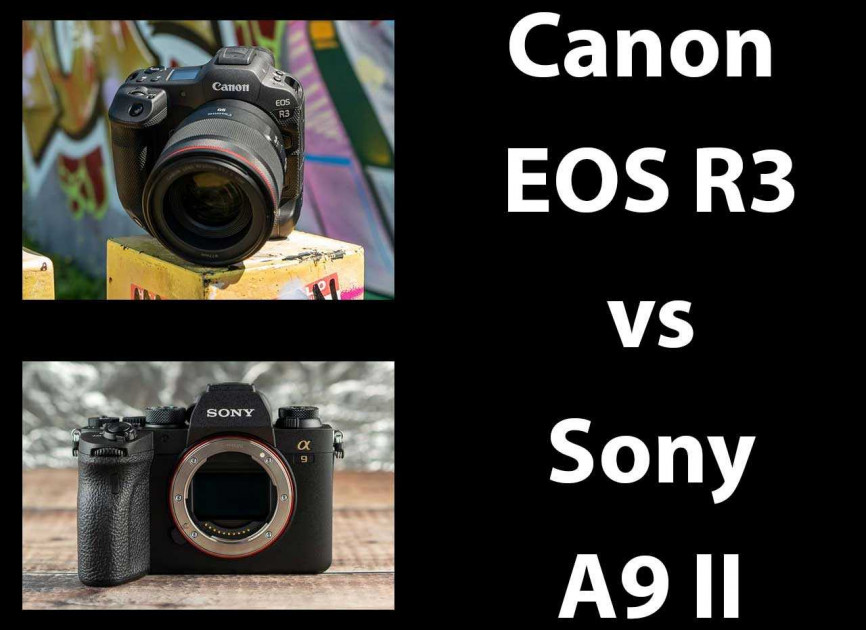Introduction
The Sony Xperia 1 III is the company’s latest flagship smartphone for 2021, available now in Frosted Black and Frosted Purple priced at £1,199 / $1,299 in the UK and USA respectively.
The main new feature in this year’s update is an innovative variable telephoto lens that has been paired with a Dual PD sensor. Essentially, the third camera module offers both 70mm and 105mm telephoto focal lengths, whereas the Xperia 1 II topped out at 70mm.
Claimed to be ‘built for speed’, you get the latest Qualcomm Snapdragon 888 processor, 12GB RAM, 5G connection and Wi-Fi 6 connectivity, new dedicated Google Assistant button, and an upgraded 4K HDR OLED display with a rapid 120Hz refresh rate and no notches.
On the image making side of things, the Xperia 1 III has triple front-facing Zeiss lenses, backed up with Photo Pro with a new Basic mode and Cinema Pro apps for full manual control over settings such as exposure, focus and drive mode.
The Xperia 1 III offers 20fps burst shooting with continuous autofocus focus and autoexposure and low light noise reduction, real time eye AF for humans and animal and new real-time tracking mode, AI super resolution zoom technology in addition to the usual digital zoom, 5x slow-motion recording in 4K HDR 120fps, and the ability to record in the 21:9 ratio at 24/25/30/60fps.
On paper, for image makers there’s a lot to be excited about in the Xperia 1 III, so read on to find out how we got on using it.
Ease of Use
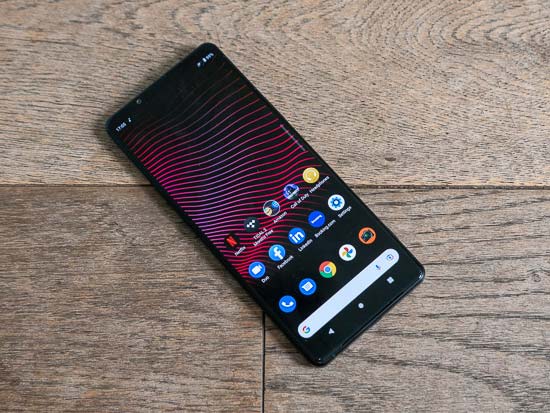 |
Before we get into the nitty gritty of the camera and apps, let’s take a look around the sleek and slender Xperia 1 III.
It’s still got an ultra-wide 6.5″, 21:9 aspect ratio 4K HDR OLED (3840×1644 pixel) screen. With a 1,000,000:1 contrast ratio and 10-bit equivalent display, the colours are rendered beautifully.
Asides from being the perfect format for watching movies and gaming, there are a few other benefits to ultra-wide screens.
With a maximised display size, the ‘multi-window’ function that allows you to view and operate two apps simultaneously has enough room to breathe – it’s a genuine option.
That ultra-wide 21:9 aspect ratio of the screen also gives a cleaner display for image making, being perfectly suited to video, but in this case also for photography. That’s because in the Pro Photo app, the camera functions and menus are displayed in the empty space to the side of the best quality 4:3 aspect ratio live view.
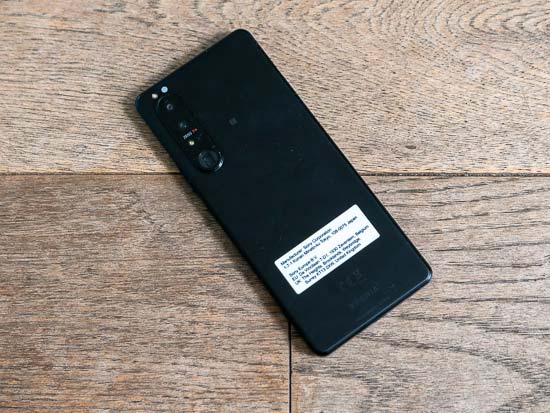 |
Overall, the screen is great, although we did find it a challenge at times to see it clearly when out in direct summer sunlight, even at its brightest setting.
The phone itself is narrower than other 6.5in phones and therefore easier to hold. However, it’s long format is unwieldy for single-hand use and you’ll generally want both of your hands free for using the camera.
Design-wise, Corning Gorilla Glass Victus on both sides make the Xperia 1 III an even tougher phone than the Mark II. You will still want to buy a protective case though, not least of which because the smooth surface is slippery.
It also offers water resistance to an IPX5/IPX8 rating and dust resistance to an IP6X rating.
The battery has an increased 4,500mAh capacity and can be charged to 50% in around 30 minutes with the supplied 30w charger. You’ll easily get a full day’s use on a single charge – a performance that matches up to the competition. There is also compatibility with a wireless charger dock, although this unit is not supplied with the phone.
A further look around the phone reveals the single SIM/ micro SDXC card slot, volume control, on/off button and a button that can be used for image capture with the camera. Lo and behold, there’s also a 3.5mm headphone jack, too, and a somewhat superfluous new dedicated Google Assistant button.
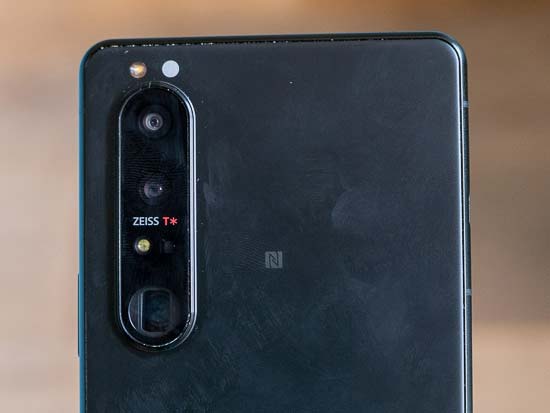 |
For quicker and easier access, we would like to see an on-screen fingerprint scanner, instead of the power on/off scanner.
As standard, the internal memory is a generous 256GB and a micro SDXC card card be installed with support for cards up to 1TB.
On the rear is the triple lens camera, flash and a 3D iToF sensor used for autofocus and depth sensing. Thankfully, the lenses are positioned in the upper left as you hold the camera in landscape format for taking photos, meaning your fingers are much less likely to get in the way.
The primary rear lens has a 24mm focal length with 82° field of view and maximum f/1.7 aperture. You then have the new dual telephoto 70mm and 105mm camera with 34° and 23° fields of view and f/2.3 and f/2.8 maximum apertures respectively, plus the 16mm ultra-wide lens with 124° field of view and f/2.2 maximum aperture. It’s also possible to digitally zoom in with any of those lenses, up to a maximum of 300mm using the 24mm lens.
There is a single front-facing ‘selfie’ camera with 8MP resolution, 78° field of view and f/2.0 maximum aperture.
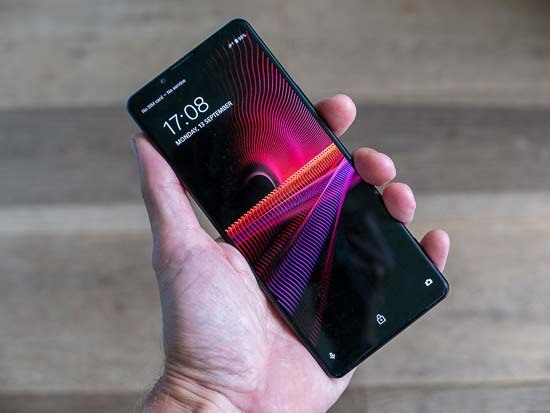 |
While out and about, we have really appreciated what each of the 16mm, 24mm and 70/105mm lenses bring. For landscape scenarios, that ultra-wide lens is particularly useful. We have largely ignored the digital zoom because of the adverse impact on image quality.
Each lens offers a maximum 12MP image size at 4:3 aspect ratio, while using a different area of the new sensor, with the primary 24mm lens utilising the sensor fully. And the camera sensor is 1/1.7”, which is 50% larger unit than the one found in the original Xperia 1.
It seems strange to consider 12MP a low resolution for a smartphone, but this very ethos has served the photo quality in Apple iPhone and Google Pixel phones very well.
For photography and video there are two main ways to control the camera, through the dedicated Cinema Pro and Photo Pro apps or through the new Basic mode, which has effectively replaced the native camera app. Note that the Basic mode is the only one that lets you use an onscreen shutter button – the more advanced shooting modes require you to use the physical shutter button instead.
In the Basic mode, you can switch between the four focal lengths, adjust brightness via a slider, manually add a bokeh effect with the 24mm, 70mm and 105mm lenses only (bokeh is the word used to describe the aesthetic quality of out-of-focus areas), select the drive mode, flash mode and aspect ratio, and switch to the front facing camera. For videos, you can adjust the brightness, turn HDR on/off, and turn the Torch on/off.
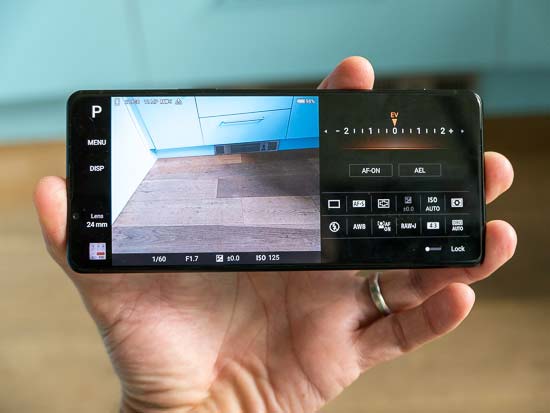 |
There are a few additional photo modes; panorama (which works really well), ‘slow motion’ (for 120fps full HD videos), Portrait Selfie, and Creative effect (for various filters including Old Film, Mirror and Harris Shutter).
To switch to the more advanced shooting modes, you now more simply select Basic in the top-right corner, which reveals a horizontal menu with five other options – Auto, P, S, M and MR.
Making the most of that ultra-wide display, the layout in the Pro apps is brilliant. Sony Alpha users will be familiar with the menu layout, with Auto and PSM exposure modes, EV compensation, Af-On and AEL buttons, drive mode, AF mode, focus area, ISO, metering, flash, white balance, Face/ Eye detection AF, file format, aspect ratio and dynamic range optimiser/HDR.
There’s even a Lock slider to prevent the camera settings from being inadvertently changed. A histogram, grid lines and level gauge can all be displayed in real time too.
Our only criticism of the Photo Pro UI is that the menu layout doesn’t automatically rotate when using the camera in portrait mode, which makes using the various onscreen icons a lot more difficult than in landscape mode. Strangely, portrait orientation does work in the new Basic mode, but not in any of the other more advanced modes,
Photos are taken in the Pro app using the shutter button on the side of the phone. Unlike the standard camera app, there is no on-screen shutter button option. We found the side shutter button a little on the stiff side, especially when trying to get a grip on the slippery rear surface. Ideally you’ll have both hands available to hold the phone.
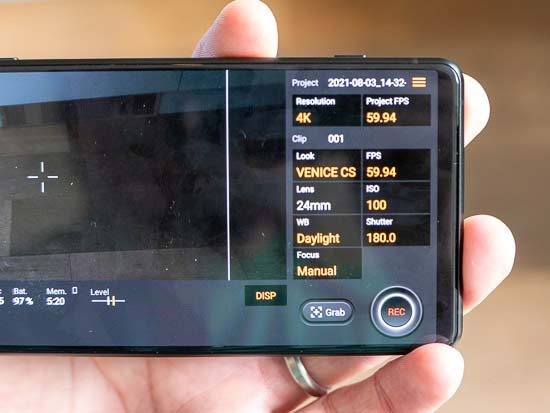 |
Ultimately, those who know a bit about photography will really enjoy the Photo Pro App. And like in the latest Sony Alpha cameras, the continuous AF in the Xperia 1 III is excellent in a wide range of scenarios.
This is helped by the new addition of real-time tracking straight from the Alpha range of mirrorless cameras. This new feature can accurately detect and focus on a subject and then keep tracking it even if it temporarily moves out of sight.
Sony’s industry-leading real-time face and eye detection AF is available here for both people and animals and has unerring accuracy and reliability.
There is the reassurance that continuous AF is on the money via those signature green squares that you get displayed over your tracked subject – be it face or eye detection.
Then there are the drive modes supported by fast continuous AF – up to 20fps with continuous AF and AE. That headline-grabbing continuous high drive mode is sadly only available when using the 24mm lens only, though, while the other lenses are supported with a still pretty fast 10fps continuous low drive mode.
In low contrast light, AF is excellent too, for a phone. Whatever the scenario, the Xperia 1 III is lightning quick for focus and capture. It almost seems absurd (in a good way) to have such action-photography-friendly features on a “mere” phone.
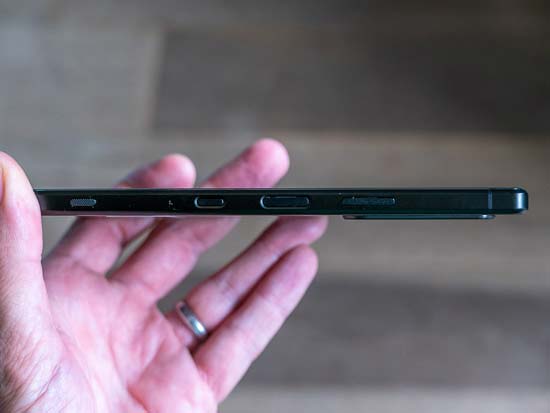 |
We also need to comment on the Cinema Pro app for video. You get 4K (3840×1644) or 2K (2520×1080) capture at up to 60fps and new 120fps slow-motion, plus eight colour grade presets in addition to a standard look. The shutter is automatically adjusted according to your FPS, whether it is 24, 25, 30 or 60fps – that’s really helpful.
All four focal lengths are available for video mode, although not all FPS options are. With a fixed aperture of f/1.7 to f/2.8 depending on the lens in use, direct sunlight is too bright even using the base ISO 50 setting and certainly when shooting at 24fps. We couldn’t find an ND filter effect option to reduce light transmission. So if you want to shoot video in sunlight, 60fps is your only real option.
Video AF is good albeit with a little ‘twitching’ as it makes those micro adjustments, while manual focus is controlled by selecting the distance on a slider.
There is a really neat feature to select two manual focus presets (‘A’ and ‘B’) on the slider to make an immediate switch between those two distances. We can see a lot of use for this feature and are still pinching ourselves that this is on a phone! Manual focus transitions are really smooth.
A general sour observation about the Xperia 1 III is that not all features are available in all modes or for all four focal lengths and it’ll take a little time to work out what is indeed possible.
All in all, the Xperia 1 III is even more capable for photo and video recording than the previous Mark II version, is backed up a more powerful processor, longer battery life and those very intuitive Pro apps. It’s not for everyone, in fact, its handling is aimed squarely at discerning image makers who will be bowled over by what is possible.
Image Quality
All of the sample images in this review were taken using the 12 megapixel JPEG setting, which produces an average image size of around 7Mb.
Noise
Manual exposure control is possible in the Photo Pro mode (although the aperture is fixed), with an ISO 64-3200 range, plus auto ISO. The ISO setting can be shifted in 1/3EV steps, and we have included identical shots taken at the base ISO and then every full ISO stop between ISO 100 and 3200, that’s almost seven stops in all.
With a maximum aperture between f/1.7 and f/2.8 depending on the lens in use, plus 5-axis image stabilisation, chances are the Xperia 1 III will be set to ISO 64 or ISO 100 via auto ISO the majority of the time. And in good contrast light such as daylight, detail is sharp in these settings.
Certainly, you’ll want to do your best to use ISO 64 or ISO 100 because the adverse effect of noise is progressive with each ISO setting increase. Viewing images at 100% size on screen, detail remains reasonably sharp up to ISO 400, then mushier from ISO 800 and higher.
In low contrast light such as shadows, JPEG detail will be a little mushier than in the brighter areas whatever the ISO setting. Noise is also influenced a little by the lens in use – you’ll get best quality pictures possible by using the primary 24mm lens.
All being said, most images will be viewed on a smartphone or tablet and will appear very sharp up to ISO 800.
| JPEG | RAW |
|
ISO 64 (100% Crop) |
ISO 64 (100% Crop) |
 |
 |
|
ISO 100 (100% Crop) |
ISO 100 (100% Crop) |
 |
 |
|
ISO 200 (100% Crop) |
ISO 200 (100% Crop) |
 |
 |
|
ISO 400 (100% Crop) |
ISO 400 (100% Crop) |
 |
 |
|
ISO 800 (100% Crop) |
ISO 800 (100% Crop) |
 |
 |
|
ISO 1600 (100% Crop) |
ISO 1600 (100% Crop) |
 |
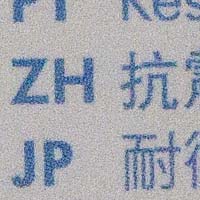 |
|
ISO 3200 (100% Crop) |
ISO 3200 (100% Crop) |
 |
 |
Focal Range
Three front lenses provide four equivalent focal lengths of 16mm, 24mm, 70mm and 105mm, with the 24mm being the primary lens. Each lens can digitally zoom in, with a maximum reach of 300mm when using the 24mm lens.

16mm

24mm

70mm

105mm
Macro
As with any small-sensor smartphone, the Xperia 1 II has decent macro capabilities. It’s minimum focus distance is approximately 10cm.



Flash
Both in the Photo Pro and the standard camera apps, the flash options are; auto, fill-flash, red-eye reduction, off and torch. Depending on lens choice, app choice and camera settings, not all flash options are available and there are inconsistencies between apps.

Off

On
Night
Shutter speed and ISO is automatic in the standard camera app, but in the Photo Pro app those settings can be manually adjusted. The maximum camera settings for night photography is a 30 second shutter speed and ISO 3200.

Sample Images
This is a selection of sample images from the Sony Xperia 1 III camera, which were all taken using the 12 megapixel JPEG setting. The thumbnails below link to the full-sized versions, which have not been altered in any way.
Sample RAW Images
The Sony Xperia 1 III enables users to capture RAW and JPEG format files. We’ve provided some Sony RAW (DNG) samples for you to download (thumbnail images shown below are not 100% representative).”
Sample Movies & Video
This is a sample movie at the quality setting of 3840×2160 pixels at 30 frames per second using the 0.7x lens. Please note that this 15 second movie is 101Mb in size.
This is a sample movie at the quality setting of 3840×2160 pixels at 30 frames per second using the 1x lens. Please note that this 15 second movie is 102Mb in size.
This is a sample movie at the quality setting of 3840×2160 pixels at 30 frames per second using the 2.9x lens. Please note that this 15 second movie is 101Mb in size.
This is a sample movie at the quality setting of 3840×2160 pixels at 30 frames per second using the 4.4x lens. Please note that this 15 second movie is 101Mb in size.
This is a sample slow-motion movie at the quality setting of 3840×1644 pixels at 120 frames per second. Please note that this movie is 146Mb in size.
This is a sample movie at the quality setting of 1920×1080 pixels at 60 frames per second. Please note that this 15 second movie is 55Mb in size.
This is a sample movie at the quality setting of 1920×1080 pixels at 30 frames per second. Please note that this 15 second movie is 33Mb in size.
This is a sample slow-motion movie at the quality setting of 1280×720 pixels at 120 frames per second. Please note that this movie is 102Mb in size.
Product Images
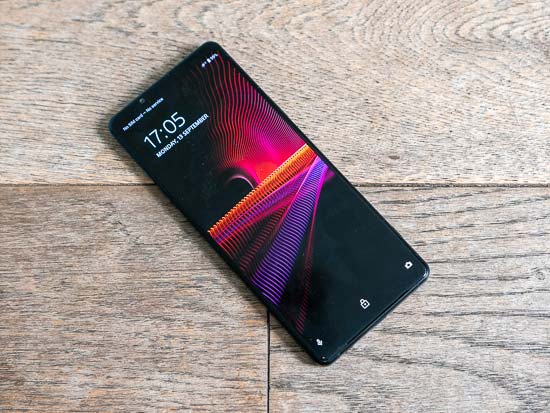

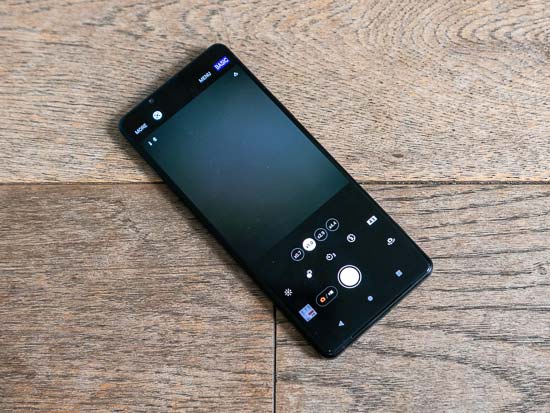
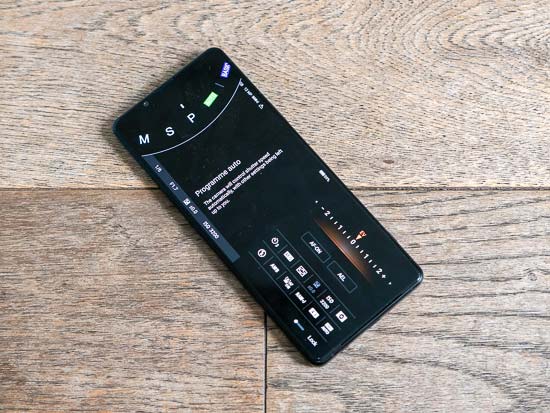

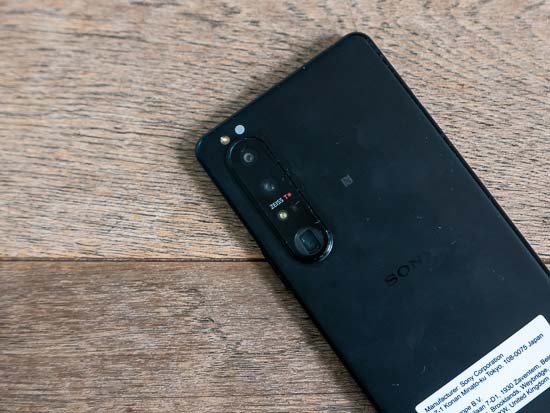




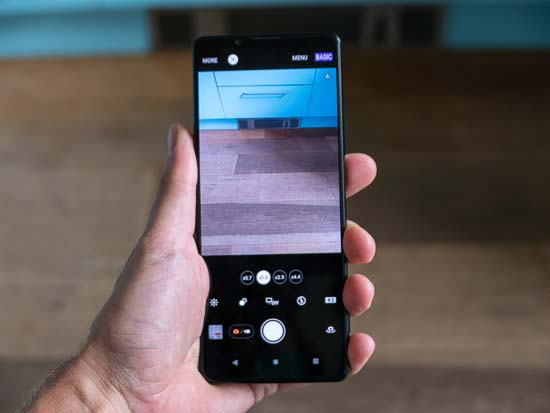

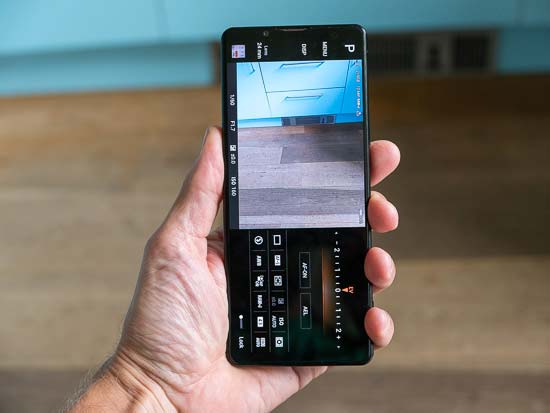

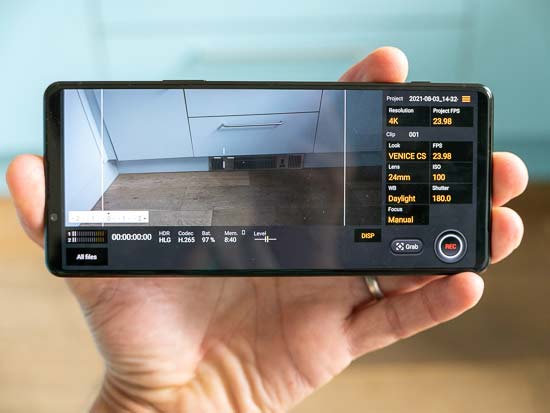

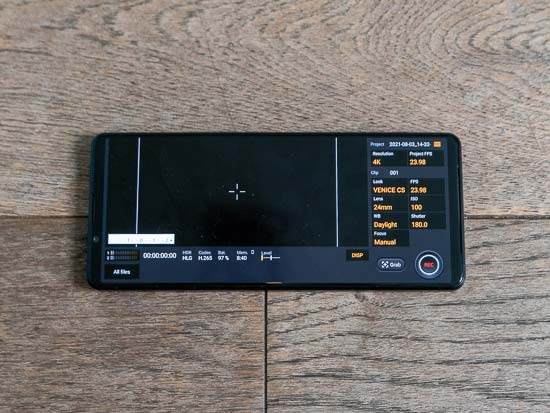
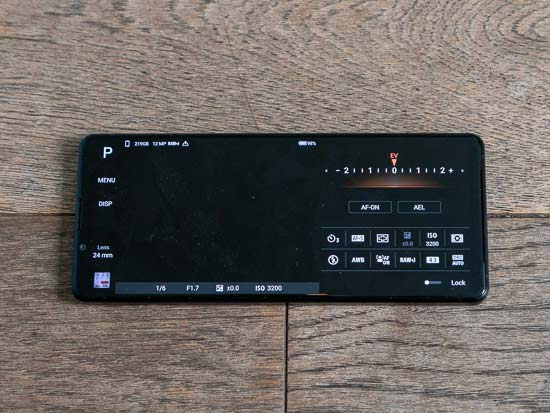
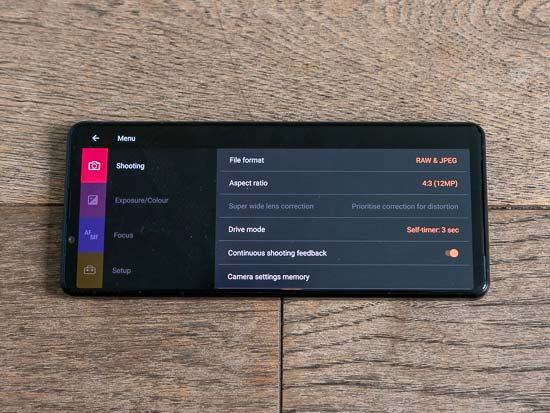
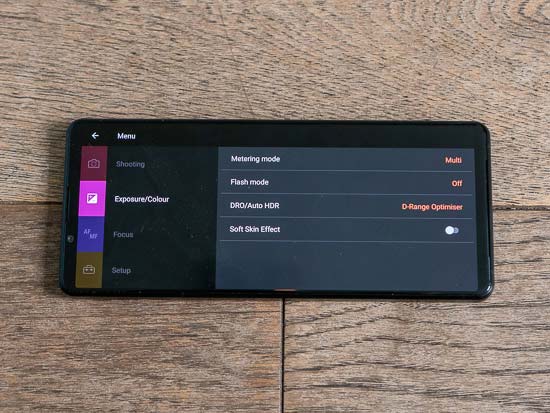
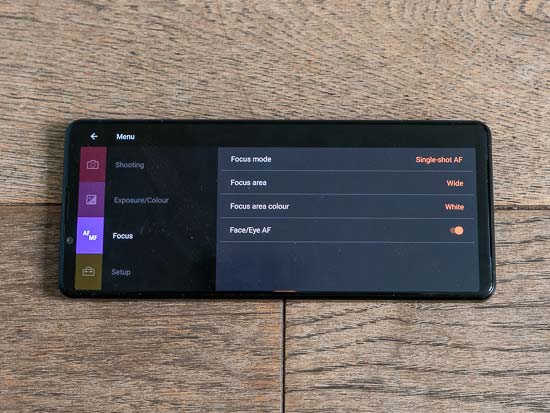
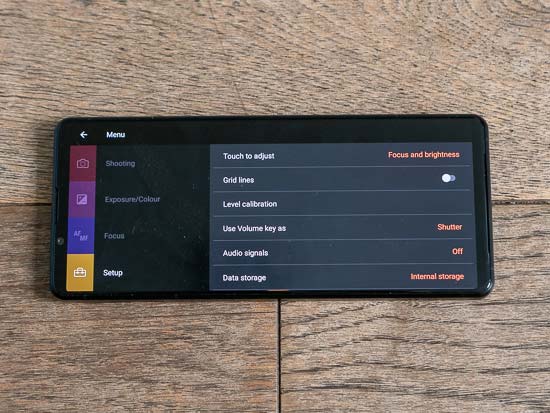
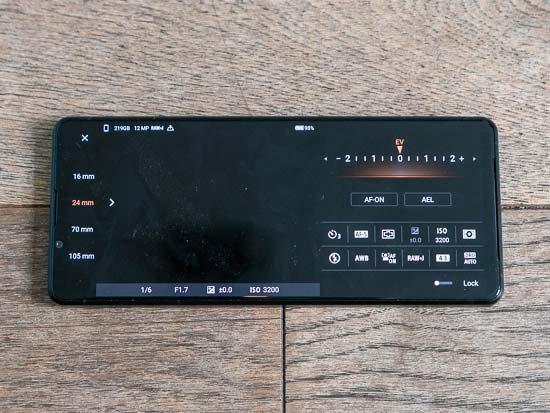
Conclusion
The Sony Xperia 1 III represents a modest rather than radical upgrade from the one-year-old Xperia 1I, with an improved display with 120Hz refresh rate, faster processor, longer battery life, 4K 120fps slow-motion movies, real-time AF tracking and the unique variable 2.9x/4.4x telephoto lens comprising the principal improvements.
We loved the Xperia II’s Photo Pro and Cinema Pro apps, and thankfully Sony have only made them even better on the Mark III by integrating a new Basic mode which effectively replaces the usual basic, automated native camera app. We only wish that all of the shooting modes supported portrait orientation, and not only the Basic mode.
Still, the fact remains that whether you are a Sony Alpha camera user or simply a photo enthusiast, the layout and handling of the Photo Pro app is arguably the best around in any smartphone, clearly designed for those who desire more creative control. If you’ve ever been frustrated by your phone’s camera app, make sure to try out the Xperia interface to see what it should really be like.
On the flip side, less experienced users may be somewhat alienated when it comes to the camera. One example is that there are still no dedicated algorithms for a ‘Night Mode’, something that most flagship phones now offer, but you can take manual control of shutter speed for night shots and achieve great results. Ultimately, you’ll have to manually work out a lot of things for yourself.
There are still plenty of quirks, too, such as certain settings that are available in some scenarios and for one of the lenses that may not be for others, with no apparent workaround.
With an RRP of £1,199 / $1,299, the launch price has crept up by £$100 compared to the Xperia II, pitching it against the very best flagship products from Samsung, Apple, OnePlus and Huawei.
It’s still a rather unique device, though, that genuinely offers something different from the mainstream, which is especially true for photographers and videographers thanks to the excellent Photo Pro and Cinema Pro apps and its reliance on the skill of the user rather than automated modes.
Sony Xperia may not be your first choice of smartphone brand, or even in your top five, but the new Xperia 1 III is a genuine challenger to the bigger smartphone names when it comes to photography.
| Ratings (out of 5) | |
|---|---|
| Design | 4 |
| Features | 4.5 |
| Ease-of-use | 4.5 |
| Image quality | 4 |
| Value for money | 3 |
Main Rivals
Listed below are some of the rivals of the Sony Xperia 1 III.
The Apple iPhone 12 Pro Max is billed as the ultimate iPhone for photographers, boasting a larger sensor for the main camera, a 2.5x zoom lens and a much bigger screen and overall size than the standard Pro version. With prices starting at around £$1099, is this really the best iPhone for photography? Read our in-depth iPhone 12 Pro Max review now, complete with full-size sample photos and videos…
The Apple iPhone 12 Pro is one of four new iPhones released for 2020, joining the Mini, Pro Max, and the standard model. With prices starting at around £$999, is this the best iPhone for photographers? Read our in-depth iPhone 12 Pro review now, complete with full-size sample photos and videos…
The Pixel 5 is Google’s flagship smartphone for 2020, yet it’s priced at just £599 / $699. Does it offer similar performance and features to other, much more expensive range-topping handsets? Read our in-depth Google Pixel 5 review to find out if what it offers photographers, complete with full-size sample photos and videos.
The P40 Pro is Huawei’s new flagship smartphone for 2020. Featuring a 6.58-inch screen, 50 megapixel sensor, 5x optical zoom lens and 4K video recording, can it overcome its much-publicized lack of Google App support? Find out now by reading our in-depth Huawei P40 Pro review, complete with full-size sample images and videos…
The OnePlus 9 Pro is the latest flagship smartphone for 2021 from OnePlus. Find out if this is the best smartphone for photographers and videographers by reading our in-depth OnePlus 9 Pro review, complete with full-size sample photos and videos.
The Galaxy Note 20 Ultra is Samsung’s latest flagship smartphone, boasting a 6.9-inch screen, 108 megapixel standard camera, 5x optical zoom, 8K video, super slow motion video, Pro shooting mode and Raw capture. Take a look at our in-depth Samsung Galaxy Note 20 Ultra review to find out if this is the best smartphone camera for keen photographers…
The Galaxy S21 Ultra is Samsung’s new flagship smartphone for 2021. Featuring a quad-camera setup with 108 megapixels and a 10x optical zoom, 8K video recording, a 5000mAH battery and 5G connectivity, is this the ultimate smartphone for keen photographers? Find out now by reading our expert Samsung Galaxy S21 Ultra review, complete with full-size sample photos and videos…
The Sony Xperia 1 II is a new flagship smartphone offering a range of pro image and video features aimed at keen camera enthusiasts. These include 20fps with continuous autofocus focus and autoexposure and real time eye AF for humans and animals, utilising technologies borrowed from the Alpha A9 full-frame mirrorless camera. Read our in-depth Sony Xperia 1 II review, complete with full-size sample images and videos, to find out if this new smartphone hits the mark for serious photography…
The Sony Xperia 5 II is a new mid-range smartphone that inherits a lot of the core features from the flagship Xperia 1 II model, in a smaller and more affordable form factor. Read our in-depth Sony Xperia 5 II review, complete with full-size sample images and videos, to find out if this new smartphone can satisfy the serious photographer…
You’ve probably never heard of Vivo before, but that shouldn’t put you off the new X51 5G, one of the best smartphones for photography that we’ve ever reviewed. What makes the Vivo X5 5G so special for both stills and video? Find out now by reading our in-depth review…
Review Roundup
Reviews of the Sony Xperia 1 III from around the web.
The Sony Xperia 1 III isn’t for everyone, but for those who enjoy Sony’s Android phones, or who want a top-tier smartphone with a versatile camera, a beautiful screen and strong battery life, this is a great choice. It’s expensive, and its design means it isn’t for everybody, but if your budget can stretch to it, and you’re a fan of its looks, it could be a great option.
Read the full review »
This could be all the phone that many will need, with a great display, plenty of power and useful features like the headphone socket and expandable storage. But the camera is complicated by Sony’s attempt to make it more ‘pro’, missing the mark hit by many others when it comes to basic performance.
Read the full review »
The Sony Xperia 1 III is a great phone that I won’t recommend to many people. Once again, Sony has created a beautiful device with some unique, marquee features like a 4K-ish OLED 120Hz screen, great photo-taking amenities like a physical shutter button and a high-quality manual camera app, and top-notch hardware for entertainment consumption, like dual front-facing speakers and an honest-to-god headphone jack. You won’t find that combination among the other big-name flagships on the market.
Read the full review »
Specifications
Specifications
Size
- DIMENSIONS
- 165 x 71 x 8.2 mm
Weight
- WEIGHT
- 186 g
Display
- DISPLAY SIZE
- 6.5″ 21:9 CinemaWide™ display
- DISPLAY RESOLUTION
- 4K HDR OLED (3840 x 1644)
- FEATURES
- 120Hz Refresh rate, 240Hz Motion blur reduction, 240Hz Touch scanning rate, Creator mode “powered by CineAlta” – Inspired by Master Monitor colour reproduction, DCI-P3 100%, ITU-R BT.2020 (REC.2020), Illuminant D65 White point, 10 bit tonal gradation, X1™ for mobile
- IMAGE PLAYBACK FORMAT
- JPEG, GIF, PNG, BMP, WebP, WBMP, HEIF, DNG, CR2, NEF, NRW, ARW, RW2, ORF, RAF, PEF, SRW
- VIDEO PLAYBACK FORMAT
- H.263, H.264, H.265, MPEG-4 Video, AV1, VP8, VP9
Durability
- WATER RESISTANT
- Water resistant (IPX5/IPX8), Dust proof (IP6X)
- DURABILITY
- Corning® Gorilla® Glass Victus™ (Front), Corning® Gorilla® Glass 6 (Rear)
Camera
- CAMERA
- Triple lens camera
Rear Camera (1)
- RESOLUTION
- 12MP
- SIZE
- 1/1.7″ Exmor RS™ for mobile sensor
- APERTURE
- F1.7
- FOCAL LENGTH
- 24 mm
- FIELD OF VIEW
- 82°
Rear Camera (2)
- RESOLUTION
- 12MP
- SIZE
- 1/2.9” Exmor RS™ for mobile sensor
- APERTURE
- F2.3 (70 mm), F2.8 (105 mm)
- FOCAL LENGTH
- 70 mm, 105 mm
- FIELD OF VIEW
- 34° (70 mm), 23° (105 mm)
Rear Camera (3)
- RESOLUTION
- 12MP
- SIZE
- 1/2.5″ Exmor RS™ for mobile sensor
- APERTURE
- F2.2
- FOCAL LENGTH
- 16 mm
- FIELD OF VIEW
- 124°
Camera Features
- FEATURES
- Photography Pro, ZEISS® quality lenses calibrated specifically for Xperia 1 III, ZEISS® T* Coating, Up to 20fps AF/AE, Up to 60 times per second continuous AF/AE calculation, Real-time Eye AF (Human, Animal), Real-time tracking, 3D iToF, Dual photo diode, RGB-IR, OIS photo, Photo flash, Photo light, Hybrid zoom 12.5x (based on Wide camera 24 mm), AI Super Resolution Zoom, HDR (High Dynamic Range) photo
- IMAGE CAPTURE FORMAT
- JPEG (.jpg), RAW (.dng)
Video Recording
- FEATURES
- Cinematography Pro “powered by CineAlta”, 4K HDR Movie recording 24, 25, 30, 60 and 120fps slow-motion, OIS and EIS Video, Optical SteadyShot™with FlawlessEye™, SteadyShot™ with Intelligent Active Mode (5-axis stabilization), Intelligent wind filter
- VIDEO RECORDING FORMAT
- .mp4 (H.264, H.265)
Front Camera (1)
- RESOLUTION
- 8MP
- SIZE
- 1/4″
- APERTURE
- F2.0
- FIELD OF VIEW
- 78°
- FEATURES
- HDR (High Dynamic Range) photo, SteadyShot™ with Intelligent Active Mode (5-axis stabilization), Portrait selfie, Display flash, Hand gesture
Audio
- HI-RES
- Hi-Resolution Audio, High-Resolution Audio Wireless (LDAC)
- OTHER FEATURES
- 3.5 mm audio jack, 360 Reality Audio, 360 Reality Audio hardware decoding, 360 Spatial Sound, Full-stage stereo speakers, Dolby Atmos®, DSEE Ultimate, Stereo Recording, Qualcomm® aptX™ HD audio
- PLAYBACK FORMAT
- AAC-LC, AAC+, eAAC+, AAC-ELD, AMR-NB, AMR-WB, FLAC, MP3, MIDI, Vorbis, PCM, Opus, ALAC, DSD, Dolby Atmos, Dolby AC-4, 360 Reality Audio Music Format
- RECORDING FORMAT
- AAC-LC , AAC+, AAC-ELD, AMR-NB, AMR-WB
Game
- FEATURES
- PS4 Remote Play, DUALSHOCK®4 Control compatibility, Game enhancer
Entertainment
- FEATURES
- Dynamic Vibration System
Memory & Storage
- RAM
- 12GB
- INTERNAL MEMORY
- 256GB UFS
- EXTERNAL MEMORY
- microSDXC support (up to 1 TB)
SIM Capability
- NUMBER OF SIM
- Dual SIM hybrid
- SIM TYPE
- nanoSIM
Operating System
- VERSION
- Android™ 11
Processor
- CPU
- Qualcomm® Snapdragon™ 888 5G Mobile Platform
Battery
- CAPACITY
- 4500 mAh
- CHARGING TYPE
- USB Power Delivery (USB PD) fast charging
- OTHER FEATURES
- Xperia Adaptive Charging, Battery Care, STAMINA Mode, Qi Wireless charging, Battery Share function
Networks
- 2G BAND
- 850, 900, 1800, 1900
- 3G BAND
- 2100 (Band 1), 1900 (Band 2), 1700 (Band 4), 850 (Band 5), 800 (Band 6), 900 (Band 8), 800 (Band 19)
- 4G BAND
- 1, 2, 3, 4, 5, 7, 8, 12, 13, 17, 19, 20, 25, 26, 28, 29, 32, 34, 38, 39, 40, 41, 46, 66
- 5G BAND
- n1, n3, n5, n7, n8, n20, n28, n38, n40, n41, n77, n78
Connectivity
- WI-FI
- IEEE802.11a/b/g/n(2.4GHz)/n(5GHz)/ac/ax
- LOCATION
- A-GPS, A-GLONASS, Beidou, Galileo, QZSS
- BLUETOOTH
- Bluetooth® 5.2 wireless technology
- USB TYPE
- Type-C®
- USB VERSION
- USB 3.1 Gen1
- OTHER FEATURES
- Smart connectivity, Google Cast, NFC, Output video/image via Display Port support TypeC Cable or USB-C to HDMI Adapter Cable (Display port 4K/60fps)
Sensors
- SENSOR TYPE
- Fingerprint sensor
Accessibility
- ACCESSIBILITY
- Hearing Aid Compatibility (HAC)
, Teletypewriter (TTY)
/SCREEN READERS: Select to Speak, TalkBack, Text-to-speech output /DISPLAY: Font size, Display size, Dark theme, Magnification, Colour correction, Colour inversion, Large mouse pointer, Remove animations /INTERACTION CONTROLS: Accessibility Menu, Switch Access, Click after mouse pointer stops moving, Power button ends call, Auto-rotate screen, Touch & hold delay, Time to take action (Accessibility timeout), Vibration & haptic strength, System navigation /AUDIO & ON-SCREEN TEXT: Mono audio, Audio balance, Caption preferences /EXPERIMENTAL: High contrast text, Shortcut from lock screen
News
The new Sony Xperia 1 III and Xperia 5 III smartphones feature the world’s first Variable smartphone telephoto lens paired with a Dual-PD sensor and 4K HDR OLED 120Hz Refresh rate display.
Both devices also offer Real-time Eye AF for humans and animals, newly equipped Real-time Tracking and fast, and accurate continuous AF across all lenses, plus 20fps Burst Mode with low light noise reduction powered by BIONZ X processor and brand new AI super resolution zoom technology.
The Xperia 1 III and 5 III will both be available from early Summer 2021, pricing to be announced.
Sony Press Release
14th April 2021, Sony today announced two new additions to its Xperia 1 and 5 flagships series line-ups with Xperia 1 III and Xperia 5 III. Both devices provide a rich collection of integrated features that connect the Xperia community with its passions. Whether they are photographers, audiophiles, cinephiles, gamers or cinematographers alike, the next generation of Xperia 1 and 5 flagships series will enrich the user experience with its plethora of new features. This is the next level of Xperia that transforms with speed and beyond.
- World´s first smartphone with a Variable telephoto lens paired with a dual PD sensor
- Real-time Eye AF for humans and animals, newly equipped Real-time Tracking and fast, accurate continuous AF across all lenses
- 20fps Burst Mode with low light noise reduction powered by BIONZ X™
- Brand new AI super resolution zoom technology
- Updated Photography Pro feature – now equipped with ‘Basic Mode’
- World’s first smartphone with a 4K HDR 120Hz Refresh rate display crafted from Gorilla® Glass Victus™
- Evolved Full-stage stereo speakers – now 40% louder than previous model
- New and improved Game Enhancer features – including a new audio equaliser, an optimised V.C microphone and high frame rate recording feature
- World’s first smartphone to reproduce 360 Reality Audio in the speakers, as the recording artist intended it to be heard
- Addition of brand new 360 Spatial Sound – for an immersive audio experience
- Qualcomm® Snapdragon™ 888 5G Mobile Platform
- Improved battery life (4500mAh) and the ability to charge up to 50% of capacity in 30 minutes with the kitted 30W charger – in addition to a newly extended battery life of up to three years
Professional technology from Alpha cameras
Xperia 1 III and Xperia 5 III were co-developed with the engineers behind Alpha series cameras, renowned for their industry-leading autofocus technology. Both models include fast, accurate continuous AF across all lenses and Real-time Eye AF. And in Xperia 5 III, object tracking technology is featured, allowing photographers to capture accurate shots of moving subjects in a wide variety of scenarios with a simple tap on the screen.
Xperia 1 III presents a more sophisticated feature set for photographers who strive for picture perfect results. Object tracking is upgraded with Real-time Tracking, allowing users to shoot the most challenging moving subjects in precise focus. Using AI-based algorithms and the 3D iToF sensor to measure distance, Real-time Tracking can accurately detect and focus on a subject and continue to track it even if it temporarily moves out of sight .
Furthermore, both models offer continuous AF that performs AF / AE calculations at 60 times per second – enabling users to shoot and store 20 shots (20fps) with high precision, accurate focus and optimised exposure . This level of performance is comparable to that used in professional sports cameras such as the Alpha 9 series. The BIONZ X™ processor enables users to shoot in low-light scenarios in Burst Mode for the first time, producing results with noise reduction that have never previously been possible in predecessor models.
Reach beyond expectation with a Variable telephoto lens
A key feature for both models is a World´s first smartphone with Variable telephoto lens paired with Dual PD sensor that reaches up to a 105mm focal length – complemented by fast autofocus thanks to its Dual PDAF sensor. When switching between 70mm and 105mm, the focus is adjusted in an instant to swiftly capture the beauty in the detail.
Photographers can further expand their creative possibilities with 16mm, 24mm, 70mm and 105mm focal lengths for shooting stunning compositions – whether that be landscapes, portraits or animals. Both models continue to feature ZEISSTM optics calibrated specifically for the Xperia smartphone. The ZEISSTM T* coating contributes to exquisite rendering and contrast by reducing reflections.
A wealth of creative opportunities
The next generation of Xperia both incorporate new AI super resolution zoom. This technology uses Sony’s AI processing to restore detail and definition to images, ensuring precision is not compromised.
Like their older siblings, Xperia 1 III and Xperia 5 III feature the Photography Pro function. Developed in collaboration with professional photographers, it mirrors many of the manual controls available in Alpha series cameras including ISO, shutter speed, EV Indicator, RAW support plus a dedicated shutter button (with embossed finishing exclusively on the Xperia 1 III). New for this year’s smartphones is the ‘Basic Mode’ feature in Photography Pro which enables fast access to a range of easy-to-use photography features including a touch shutter button, portrait orientation, artistic bokeh effect, panorama, and more.
The Xperia 1 III and Xperia 5 III also features the very latest Optical SteadyShot™ with FlawlessEye™ , which couples the image sensor’s increased reading speed with original Sony algorithm for optical image stabilisation. The result is supremely smooth, shake-free video footage.
Transporting cinephiles to the big screen
Whether on the go or at home in comfort, the new Xperia models are a true cinephiles dream. Xperia 1 III features a larger than life 6.5” 21:9 CinemaWideTM 4K HDR OLED display with 120Hz Refresh rateiv whilst Xperia 5 III offers a stunning 6.1″ 21:9 CinemaWide™ HDR OLED display with 120Hz Refresh rate. Both models transport users into a uniquely immersive viewing experience, allowing them to lose themselves in their favourite movies or TV shows.
Users can now enjoy their favourite entertainment as the producers intended with the Creator Mode. “Powered by CineAlta”, it now features a factory calibrated OLED display with highly accurate white point which mirrors the colour reproduction of Sony professional colour monitors used in leading Hollywood studio productions. Additionally, both models feature 10-bit equivalent displays (8-bit with 2-bit smoothing) that can display a myriad of colours without banding and support BT.2020 colour space.
Xperia 1 III and Xperia 5 III capture the senses and offer an audio-visual experience like no other. Consistent with their predecessors, they benefit from the X1™ for mobile engine which brings BRAVIA HDR remastering technology to everything users watch meaning that content is beautifully expressive. Streaming content is more lifelike than ever with more contrast, colour and clarity. Likewise, thanks to the continued incorporation of Dolby Atmos® sound tuned in collaboration with Sony Pictures Entertainment, users can experience a fully immersive, multi-dimensional performance with headphones or the smartphone’s built-in Full-stage stereo speakers.
Play to win
Gamers can gain a key advantage with the superior upgrades in Xperia 1 III and Xperia 5 III. The familiar 21:9 display transports players into the thick of the action and thanks to a new and improved 120Hz Refresh rate display , now incorporated in the 1 series, as well as the 5 series, fasting-moving objects are rendered clearly for seriously smooth gameplay. The addition of 240Hz Motion blur reduction also means the display updates at an incredible 240 times per second for blur-free, crystal clear performance. 240Hz Touch scanning rate also ensures that the action happens exactly as intended and a crucial advantage over the competition.
Another new feature in both models is the ability to adjust white balance – reducing strain on the eyes and allowing for longer durations of mobile gameplay. The new L-y raiser (low gamma raiser) also makes it easier to see opponents in the dark by adjusting image details in dark areas and highlighting enemies without overexposing bright areas of the screen.
Combining visual excellence with an immersive audio experience is key for both Xperia 1 III and Xperia 5 III. Gamers can plug-in their favourite headset via a 3.5mm headphone jack and experience the audible benefits of the models’ new features with minimal latency. The new Audio equaliser lets users control, heighten and minimise sounds such as footsteps and gunshots, allowing them to hear their opponents approaching and react ahead of them . And for those playing in teams, the new optimised V.C. microphone allows for clear communication by reducing background noise based on the users chosen headset type .
Avid gamers can now relive winning moments in all their glory thanks to high frame rate recording at up to 120fps . Whatever they are playing, R.T. record (Rewind time record) automatically pre-records 30 seconds of game footage. So gamers can easily rewind and capture key moments like match-winning plays and share them online with friends and fellow competitors.
Finally, thanks to incorporated Heat Suppression power control (H. S. power control), gaming performance remains uncompromised. By powering the phone systems directly, rather than charging the battery, thermal stress on the handsets is reduced and overheating is avoided.
Create movies like the professionals
Cinematography Pro “powered by CineAlta” enables more choice for engaging, storytelling with dramatic slow-motion cinematography creation, all within a 4K HDR 120fps slow-motion movie recording feature which can capture and playback up to 5x slow-motion when set at 24fps. It also records in 21:9 ratio at 24/25/30/60fps, enhancing cinematic expression. Eight different Look colour management pre-sets allow you to completely change the mood of your scenes, utilising different cinema styles, a vital tool in advanced storytelling. Sony’s unique Intelligent wind filter technology uses award-winning audio separation technology to reduce wind interference for clearer audio recording.
New features within both models include a range of UI improvements designed specifically with movie makers in mind. For instance, to help users control their workflow, they can easily check how much free memory is remaining and how much recording time is still available. They can also easily check which parameters they used on a specific clip, in order to apply them to other projects. Each clip’s parameter details now include resolution, FPS, look, lens, stabiliser, WB, ISO, shutter angle/ speed, focus and audio level. This is further complemented with the ability to review and organise footage with clip playback, allowing users to play back clips with a simple swipe on the phone’s display.
Audio playback as the recording artist intended
Much like the immersive experience for cinephiles, the new Xperia models utilise sound tuned in collaboration with Sony Music Entertainment. In addition to unique hardware decoding, a newly developed speaker virtualiser enables Xperia 1 III and Xperia 5 III to be the world’s first smartphones to reproduce 360 Reality Audio in the speakers.vii Listeners can Immerse themselves in sound that is so authentic, it will feel like they are at a live concert or with the artist recording in a studio. All enjoyed through the Full-stage stereo speakers or with wired or wireless headphones. To top it off, new TIDAL subscribers will get three months of TIDAL Hi-Fi free when they buy either model, including the 360 Reality Audio experience.
If the music source being listened to is 2-channel stereo, the new 360 Spatial Sound comes into play. It enables the Xperia 1 III and Xperia 5 III to upmix stereo tracks and virtualize to an immersive sound experience, in real time. The technology works with local audio files and streaming services to further enhance the listening experience.
High-quality music can be further enjoyed through the Full-stage stereo speakers or when listening with headphones either wirelessly or with the 3.5mm audio jack. The Full-stage stereo speakers are placed at the front of the phone to effectively reproduce the sound field. And as an exclusive update for Xperia 1 III, are now 40% more powerful than its predecessor . This is thanks to a new speaker box structure, which has been designed both to improve sound pressure and eliminate vibration. The audio volume through audio-out (via the 3.5mm audio jack) has also been improved by approximately 40%, while sound quality has improved with less distortion near the maximum output level.
As well as High-Resolution and High-Resolution Wireless Audio, both Xperia 1 III and Xperia 5 III continue to offer DSEE Ultimate which enhances the quality of digital music using Sony AI technology, including audio and video streaming services. It automatically improves audio frequency and dynamic range in real-time, taking each track close to high-resolution audio.
All the speed you need
Combining 5G and Wi-Fi connectivity with the latest Qualcomm® Snapdragon™ 888 5G Mobile Platform, the next generation of Xperia raises the bar for smartphone performance. This is thanks to the Qualcomm® Kryo™ 680 CPU enabling 25% higher performance and Qualcomm® Adreno™ 660 GPU delivering 35% faster graphic rendering than the previous generation.
Smart connectivity takes Xperia’s deep learning technology that utilises Sony’s Neural Network Libraries and analyses Wi-Fi signals to predict near-future connectivity issues. The Xperia 1 III and Xperia 5 III assesses the quality of available Wi-Fi before connecting so there’s no more grabbing Wi-Fi that doesn’t work. If it predicts any compromise in Wi-Fi connection quality, it uses mobile data instead.
With a 4,500mAh battery, both models offer plenty of power to keep users going through the day while a range of charging features helps maximise convenience and prolong battery life. When the battery needs a boost, it can be charged up to 50% in just 30 minutes with the included charger XZQ-UC1. Furthermore, Xperia Adaptive Charging allows the battery life to be extended up to three years (up from two in previous models) in both models. Xperia Adaptive Charging works by monitoring the phone as it charges, to make sure the battery isn’t overworked.
Finally, Xperia 1 III offers a wireless charging and Battery share function, allowing the device to be connected to a wireless charger to conveniently top up the battery. Thanks to the Battery share function, it can double as a charging pad for other devices too.
Sleek design with functionality in mind
Both Xperia 1 III and Xperia 5 III are crafted to be robust. The Xperia 1 III combines high-quality materials with a bold and distinctive design. From the frosted glass on the back to the blasted metal frame, it’s an irresistible blend of form and function. It also features Corning® Gorilla® Glass Victus™ on the display, the toughest Gorilla® Glass yet – boasting improvement in both drop and scratch performance. Meanwhile, the Xperia 5 III is its compact cousin featuring Corning® Gorilla® Glass 6™ on the rear and the display with a sleek mirror-glass finish and a robust metal frame. For further peace of mind, both models also feature IP65/68 water resistance and protection against dust.
For the busy multi-taskers, both models feature upgrades to the multi-window functionality. With the pop-up window feature, users can easily handle a new task, then get right back to what they were doing.
Last but not least, when paired with Sony headphones , users can easily access the Sony | Headphones Connect app using the new Side Sense menu for swift connectivity.
Accessories
Both models are available with a new and improved Antibacterial Style Cover. Designed with durability in mind, the covers feature a built-in stand to support horizontal placement and provide a comfortable viewing experience. They are also coated with anti-bacterial material that has a protection rate of up to 99.9% – preventing cell growth and maintaining cleanliness.
A 30W compact charger is also available and features USB-C power delivery. Safely designed for overheat protection, this new charger is certified with PPS support (Programmable Power Supply) to reduce heat impact.
Availability
Xperia 1 III will be available in Frosted Black and Frosted Purple, and shipping with AndroidTM 11 from early Summer 2021.
Xperia 5 III will be available in Black and Green, and shipping with AndroidTM 11 from early Summer 2021.
Image Gallery
Click on a thumbnail to see the full version.
Your Comments



